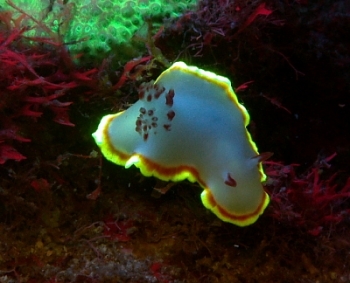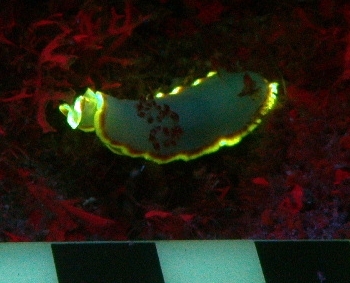More on flourescence
August 13, 2007
From: Alicia Hermosillo

Dear Bill,
Continuing with the flourescence [message #20387 ], here is a link that some people might find interesting:
http://www.nightsea.com/history.htm
It is true that there is very little information on why some nudibranchs have it and some not, but I believe it to be a very useful complementary tool that helps finding species that are otherwise hard to find.
Here is a photo I thought you might enjoy of Glossodoris sedna. Note the flourescence of the Porites coral [upper left of top photo]. The red surrounding the animal is algae which in daylight is brown.
Locality: Socorro Island, Revillagigedo Archipielago, 65 feet, Colima, Mexico, Tropical eastern Pacific, 12 April 2007, Rocky subtidal. Length: 32 mm. Photographer: Ali Hermosillo.
Cheers!
Alicia
gueri25@hotmail.com
Hermosillo, A., 2007 (Aug 13) More on flourescence. [Message in] Sea Slug Forum. Australian Museum, Sydney. Available from http://www.seaslugforum.net/find/20431
Thanks Ali,
It is certainly a spectacular tool
Best wishes,
Bill Rudman
Related messages
-
Re: How do sea slugs make their colour?
From: Janine Cindy M. Santiago, August 5, 2006 -
How do sea slugs make their colour?
From: Janine C. Santiago, July 28, 2006
